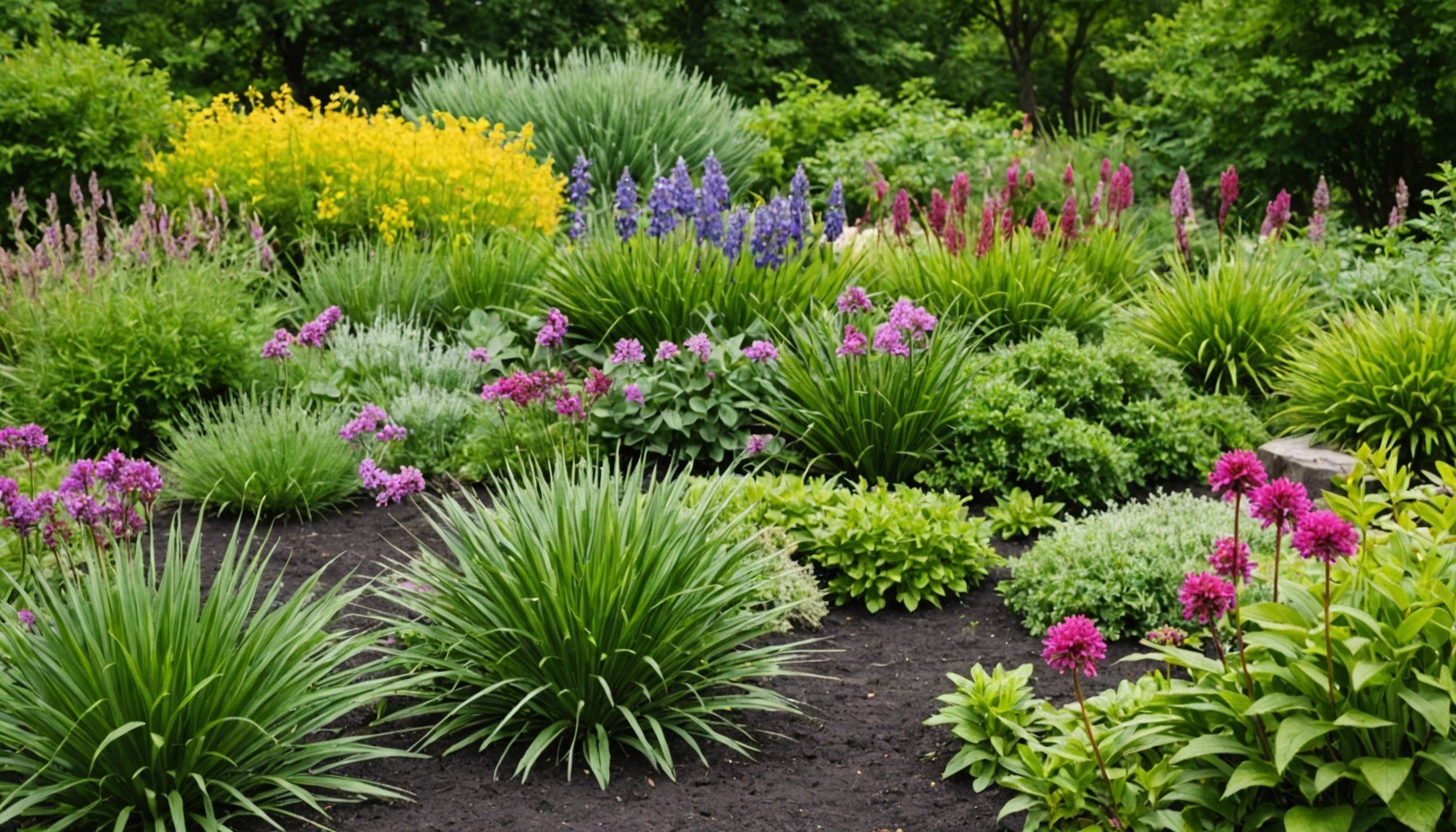Overview of Essential Native Plants
Understanding the significance of native plants in urban garden renovation is crucial for promoting biodiversity. Native plants are indispensable to urban ecosystems as they maintain the natural balance and stock a vibrant environment. They are uniquely equipped to support local wildlife and pollinators, such as bees and butterflies, which are essential for the pollination of various plant species.
Native plants also offer a visual and ecological appeal that non-native species often cannot match. They have adapted to local climates and soils, making them easier to care for while contributing significantly to the landscape’s natural beauty. Their blossoms and foliage provide visual interest throughout the seasons, dynamically altering the garden’s aesthetic allure.
This might interest you : Transform your kitchen into a zero-waste oasis: explore the top sustainable design layouts for eco-friendly living
Incorporating native species into urban environments can transform a garden into an ecological haven that is both pleasing to the eye and beneficial to the ecosystem. By choosing the right native plants, gardeners can create sanctuaries that support a diverse range of wildlife species, offering them food and shelter. This not only enhances the biodiversity of urban areas but also empowers them with self-sustaining green spaces that require less intervention and are more resilient to pests and diseases.
For a thriving garden renovation project, the inclusion of these vital native plants is essential.
In the same genre : Elegant drawer organizer styles that enhance classic shaker kitchen aesthetics
Top Native Plants for Urban Wildlife Conservation
Choosing the best native plants for wildlife conservation is a pivotal step in crafting an urban garden that thrives ecologically. These plants not only bolster the presence of local wildlife but also lend a hand in preserving biodiversity by providing habitat and nourishment.
Plant 1: Description and Benefits
A foundational choice for urban settings is the Red Maple (Acer rubrum). Known for its adaptability, it thrives in varied soil types and supports numerous species, providing food and shelter for birds and insects throughout the year.
Plant 2: Description and Benefits
Milkweed (Asclepias spp.) is indispensable for its ability to attract butterflies, especially the endangered monarch butterfly. Its nectar-rich flowers and specific foliage cater to the needs of these vibrant pollinators, ensuring their presence in your garden.
Plant 3: Description and Benefits
Goldenrod (Solidago spp.) offers sturdy growth and abundant flora that draw bees and other beneficial insects. Its yellow blooms not only brighten up urban landscapes but also sustain pollinators well into autumn.
Incorporating these three native plant species can significantly enhance urban wildlife conservation efforts, while contributing to an aesthetically pleasing and environmentally resilient garden space. Their ability to flourish with minimal care further underscores their suitability for urban garden projects.
Practical Cultivation Tips
Cultivating a thriving urban garden requires attention to specific urban gardening tips to ensure that your native plants flourish. Understanding soil conditions is crucial. Native plants often thrive in their regional soil, so assess your garden soil and consider amending it with organic matter if necessary to mimic native conditions.
Watering practices should prioritise efficiency. Native plants typically require less water once established, but initial planting stages may need regular watering until roots are well-set. Morning watering is beneficial as it reduces evaporation and prevents fungal diseases.
Maintenance is key to a successful garden. Keep an eye on plant health, removing dead foliage and ensuring that plants are not competing for sunlight or resources. Utilize organic methods such as composting to encourage plant growth and health. This enhances soil fertility without chemical dependence.
Practicing organic pest control supports plant resilience against pests and diseases. Examples include introducing beneficial insects or using natural deterrents like neem oil.
Urban gardening can be transformative, offering not only aesthetic value but ecological benefits with proper care and plant care techniques. Eco-friendly practices not only advance plant health but also nurture a sustainable environment for urban dwellers and wildlife alike.
Integrating Native Plants into Your Urban Garden
Incorporating native plants into your urban garden can be both attractive and ecologically beneficial. Thoughtful garden design ensures harmony between aesthetics and biodiversity.
Layout Design Strategies
When integrating native plants, understanding layout design is crucial. Mix heights and textures to create visually engaging layers. Incorporate elements like shrubs and groundcovers to establish a diverse, functional environment. Group plants with similar water needs to promote health and ease of maintenance.
Companion Planting Techniques
Utilize companion planting to enhance your garden’s ecology. Pair plants that support one another—for example, group pollinator-friendly flowers with those that repel pests naturally. This synergy promotes stronger plant growth and reduces the need for chemical interventions.
Seasonal Blooming Guides
For constant visual appeal and wildlife attraction, follow seasonal blooming guides. Strategically plan for a sequence of blooms throughout the year. This not only sustains the garden’s visual charm but also supports continuous wildlife presence, as different species are drawn to blooming plants at varying times.
Thoughtful planning when incorporating native plants ensures beautiful yet sustainable urban green spaces. These practices not only visually enrich your garden but also enhance its ecological function, supporting biodiversity and urban wildlife conservation efforts.
Resources for Sourcing Native Plants
Sourcing native plants for your urban garden can greatly enhance its ecological benefits. Understanding where to purchase these plants is key for a successful garden renovation. To start, explore local nurseries. They often carry species acclimated to your region’s climate and soil, ensuring the plants thrive.
Alternatively, consider attending local plant sales. These events frequently offer a wide variety of species and provide opportunities to discuss best practices with other gardening enthusiasts. Gardening groups in your area are invaluable resources, offering advice and sometimes even swapping rare or hard-to-find species among members.
If local options are limited, online retailers can be a viable option. However, sourcing from these should be done with caution; ensure the vendors specialize in native species suitable for your locale. Researching the origin and growing conditions of plants they offer ensures you are acquiring appropriate candidates for your garden’s needs.
Prioritising region-appropriate species supports your garden’s health and sustainability, fostering a self-sustaining ecosystem. By choosing plants that naturally belong in your area, your garden will not only support wildlife more effectively but will also require less water, fertiliser, and pesticides.
Local Gardening Practices for Wildlife Support
Navigating sustainable gardening involves a strategic mix of local practices.
Community Engagement and Education
Engaging local communities in sustainable gardening fosters a shared commitment to ecological well-being. Organise workshops and informational sessions to raise awareness about the benefits of native plants. These activities can cultivate a collective responsibility towards urban wildlife conservation, ensuring residents understand the importance of biodiversity in their gardens.
Applying Eco-Friendly Gardening Techniques
Eco-friendly techniques, such as mulching and organic pest control, are pivotal in maintaining a garden’s health while supporting wildlife. Mulching helps retain soil moisture and suppresses weeds, reducing the need for chemical interventions. Similarly, natural pest control methods minimise harm to beneficial insects, allowing a balanced ecosystem to flourish.
Monitoring Wildlife Interactions
An integral part of sustainable gardening is monitoring how wildlife interacts within your garden. Observing which species frequent your garden can provide valuable insight into its ecological impact. This information helps gardeners tailor their practices to support desired wildlife, encouraging a thriving habitat. Implementing changes based on these observations ensures your garden remains a cohesive ecosystem, promoting both plant and wildlife prosperity.











